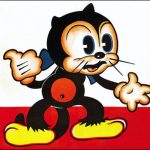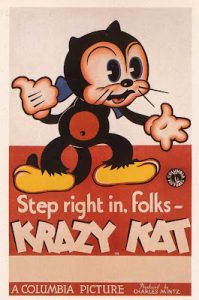


 More from the same theatrical season as last time, with an increasing tendency of Joe De Nat (and possibly mystery lyricists) to compose new pieces exclusively for use within the cartoons. This becomes particularly notable in two Color Rhapsodies featured in today’s survey, which include rich thematic scores.
More from the same theatrical season as last time, with an increasing tendency of Joe De Nat (and possibly mystery lyricists) to compose new pieces exclusively for use within the cartoons. This becomes particularly notable in two Color Rhapsodies featured in today’s survey, which include rich thematic scores.
Goofy Gondolas (12/21/34) – This cartoon shies away from the “Let’s imitate Disney” formula they’d been starting to use. Krazy is serenading in an unspecified Italian city, where every street is Canal Street. The serenade is joined by Kitty, singing in an admirable mezzo-soprano, and some of the local water fowl as well. No particular plot, but lots of Italian songs that were used as markers for anything Italian. Song: “Ciribiribin”, which was recorded by the Columbia Orchestra around 1916, the Victor Orchestra on Victor, Louise and Fererra on Supertone circa 1924 and also Pathe, and by the Belmont Choir on Italian HMV circa 1927. Lucrezia Bori issued a classical rendition on Victor red seal. In the late 30’s, it was discovered that the song could be made to swing. Nat Gonnella seems to have been the first to arrange it for swing, on English Parlophone. Harry James, that consummate show-off, did two versions – an instrumental that he used for his theme song on Brunswick, and a vocal with English lyric performed by a young crooner named Frank Sinatra on Columbia. There’s been some speculation that the instrumental version was recorded with some effort to create an echo effect, by setting up a speaker and microphone in the nearest men’s room. Les Brown covered it for Bluebird. It was also swung lightly and politely by Kurt Hasenphlug on German Tempo in 1940. They were probably able to get away with it despite swing being verboten because the original song was Italian. Two other vocal versions appeared, by Bing Crosby and the Andrews Sisters in their debut session together on Decca, and much later, by Les Paul and Mary Ford on Capitol. Ken Griffin also did his skating rink-style organ rendition on Rondo.
The Gloom Chasers (1/18/35) – Scrappy and Oopie are going along singing their happy sons, hoping to spread good cheer and slap each other on the hind end. But they find a place where Margie is all disconsolate. There hasn’t been any rain in a while, and all the animals are woebegone. The cow is dry, and the hens won’t lay. Scrappy and Oopie go on singing, and eventually bring some rain. No rain pills needed or used. Song: “We’re the Entertainers”, an original, possibly with lyrics by Art Davis, who is credited with the story. No known commercial recordings.
The Shoemaker and the Elves (1/20/35) – Here’s the Charles Mintz version of the old familiar tale. Pretty much as you’d expect such tale to go. A waif is trudging through the snow, and is about to freeze his – you know – off, nut is taken in by a kindly old shoemaker who is out of stock. The shoemaker is rewarded by a community of elves, who make for him a shop full of shoes. The waif is taken in, and given the chance to be the shoemaker’s son, providing the requisite happy ending. There are some signature Mintz touches to this retelling, including a Greta Garbo impression with reference to her big feet. Also, a brief blackface sequence with the elves singing “All God’s Chil’un Got Shoes”. This perhaps features one of the best Joe De Nat scores of the period, including two principal songs: A narrative exposition which I’ll simply all “The Shoemaker and the Elves”, and a tune which could potentially have been the hit of the film had it been properly promoted: “Helping Another Brother Along”. This film may also be said to come the closest of the early Mintz films to holding its own against the Disney Silly Symphonies.
The Bird Man (2/1/35) – Forget about Alcatraz. This cartoon is all about Krazy wanting to fly like a bird, and constructing wings out of woof, all nailed together and suoposedly working. KK loses his wings and winds up getting tarred and feathered. In his new coat of feathers, Krazy is free to mingle with a variety of feathered friends, but is eventually knocked out of the trees when another of his own species seeks a meal among the avians. Song: “I’m a Bird Man”, not much of a song, but an original, as usual with no known commercial recordings.
The Gold Getters (3/1/35) – A collection of gags about trying to find gold in them thar hills, including scenes at a California saloon, and at the diggings. Scrappy winds up as the mixologist at the saloon, and doesn’t even have to fend off a villain or deal with much of any plot. Song: “Gonna Get Some Gold”, an original expository number sung in modernistic quartet manner by four scraggly miners.
The Hot-Cha Melody (3/15/35) – Scene: Tin Pan Alley, with all the windows open and the music of the out-of-tune pianos playing. They’re all enthusiastic in pushing a song called, “I’m Happy, I’m Happy”. Krazy is in his own digs, trying to compose a new and catchy song. It uses the gag of pacing the floor until you wear a groove in it. Krazy decides to set a new lyric to Schumann’s “Traumeri”, rousing the ire of the ghost of Schumann, who rightfully claims that Krazy has stolen his song. Within a few years, Schumann could have been joined by Flotow, Debussy, Tchaikowsky, and a host of others, as band leaders everywhere seemed to be cannibalizing the classics for swing fodder. (And what would they have had to say about Spike Jones?) Songs: “I’m Happy, I’m Happy”, an original, and “The Hot-Cha Melody”, the new lyric set to “Traumeri”.
Make-Believe Revue (3/22/35) – Mother Goose Land is putting on a stage revue for a visiting little boy, and there seem to be a variety of acts, musical numbers, and comedians. At no point do we go to backstage story, or boy-girl shenanigans. There are some scenes that suggest that this film would have been spectacular had Columbia had access to 3-Strip Technicolor – instead, dealing with only 2-strip, they give us as close to a rainbow as they thought the process would permit. This may well have pleased the exhibitors and the customers, and was certainly the most opulent Color Rhapsody to date. Songs: All originals – a “Make-Believe Revue” theme song, “We Are the Chorus” (reminding one of Bugs Bunny’s number of similar purpose in the later “What’s Up Doc?”), “The Toy Soldier’s Drum”, “Bubble Land”, and a feel-good finale, “Color The Dark Clouds Away”, a number possibly inspired by “Painting The Clouds With Sunshine” from Warner’s “Gold Diggers of Broadway”.
The Graduation Exercises (4/12/35) – It’s the last day of school. Scrappy and Oopie are both on their way. Oopie falls into a pond, and Scrappy has to dry him off – causing them both to be late to school and locked out. A member of the local school board is attending the commencement that day (the board depicted on a picture as old men with white beards). The teacher is also standard old bat. While the class pretty boy gets up an recites within. Scrappy sees a suit of clothes hanging on a line, looking much like a scarecrow. He decides to use them to clothe himself and Oopie standing on his shoulders, plus borrow a fake beard from the picture, to pose as a member of the school board and gain entry to get his diploma. Eventually, a sneeze reveals the disguise, and teacher takes after the two with a switch. A confusing ending has teacher caught in the disguise by the real school board member, who abruptly leaves without giving diplomas at all. Yet Scrappy and Oopie still sing about no more teacher’s dirty looks. Song: “It’s Graduation Day”, a song celebrating the end of school, another original.
NEXT TIME: More from 1935!